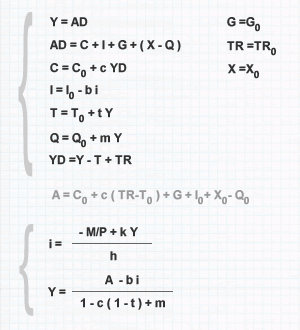LM Curve
The LM curve (LM schedule) represents the monetary market's equilibrium function. On a Cartesian plane, the LM curve denotes all combinations of interest rate (i) and income (Y) that ensure equilibrium in the money market. The LM curve is a critical component in the IS/LM model to determine the overall macroeconomic equilibrium. The monetary market equilibrium function is termed LM since it denotes the conditions where the demand for money (L) equals the real money supply (M). The acronym LM is derived from the fusion of these two letters. To construct the LM curve, one must start from the monetary market equilibrium, which occurs when the money supply (M) matches the money demand (L).
M=L
The real money supply (M) is determined by the ratio of nominal money amount (M0) to the price level (P), while the demand for money (L) is directly correlated with income (Y) and inversely with the interest rate (i).
We can thus rewrite the monetary market equilibrium condition (M=L) as follows:

By highlighting the interest rate (i) on one side of the equation, we can derive the function that identifies all the equilibrium points in the money market.

The monetary market equilibrium function can be graphically represented on a Cartesian diagram by placing the interest rate on the vertical axis and income on the horizontal axis. This graphical representation is known as the LM curve or LM schedule.

Slope of the LM Curve. The LM curve is positively sloped because there is a direct relationship between the interest rate (i) and the income level (Y). An increase in income prompts market participants to raise their demand for money. With a constant real money supply, they are compelled to sell their securities to acquire additional monetary reserves. This action depresses security prices and raises interest rates.
Steepness of the LM Curve. The greater the sensitivity (h) of money demand to interest rate changes, the flatter (more horizontal) the LM curve becomes, as a minor change in interest rate significantly affects money demand (L). Conversely, the higher the monetary requirement per unit of income (k), the steeper (more vertical) the LM curve becomes, as market participants require more money (L) to manage the increase in transactions.

